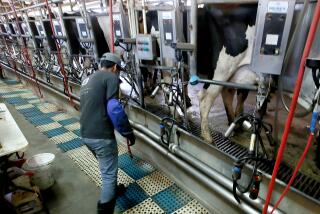U.S. to Cut Mad Cow Tests 90%
- Share via
WASHINGTON — The U.S. Department of Agriculture is cutting its tests for mad cow disease by about 90%, drawing protests from consumer groups.
The current testing level -- 1,000 each day -- reflects the heightened concern that followed the discovery in December 2003 of mad cow disease in the United States.
Since then, tests have turned up two more cases of the disease, known medically as bovine spongiform encephalopathy. The government says there may be a handful of undetected cases.
“It’s time that our surveillance efforts reflect what we now know is a very, very low level of BSE in the United States,” Agriculture Secretary Mike Johanns said Thursday. “There is no significant BSE problem in the United States, and after all of this surveillance I am able to say there never was.”
Critics, however, say now is not the time to scale back on the testing, which has cost the government an estimated $1 million a week.
“It surely will not encourage consumers in the U.S. or Japan to rush to the store to buy more beef,” said Carol Tucker Foreman, food policy director at Consumer Federation of America.
A second group, Consumers Union, advocates testing every animal slaughtered in the U.S.
The current level of 1,000 tests each day represents about 1% of the 35 million cattle slaughtered annually in this country. Beginning around late August, the new level will be about 110 tests a day.
Johanns said testing had nothing to do with the safety of U.S. beef for consumers in America and abroad. From a food safety standpoint, the real key is removing at slaughter those cattle parts known to carry mad cow disease, he said.
More to Read
Sign up for Essential California
The most important California stories and recommendations in your inbox every morning.
You may occasionally receive promotional content from the Los Angeles Times.













